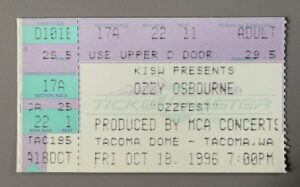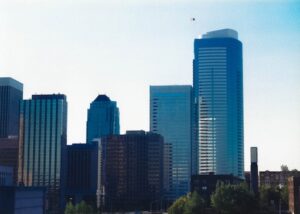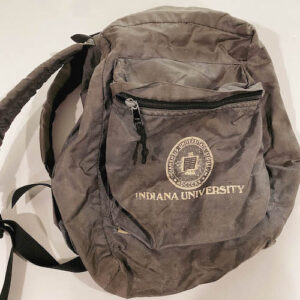 Yesterday, I drove out to Atwater to the Castle air museum. I’d been there almost ten years ago, but wanted to go back to see a recent acquisition sitting in their restoration hanger: an F-117A stealth fighter.
Yesterday, I drove out to Atwater to the Castle air museum. I’d been there almost ten years ago, but wanted to go back to see a recent acquisition sitting in their restoration hanger: an F-117A stealth fighter.
I know, the F-117 isn’t really a stealth “fighter” – it’s really more of an attack aircraft. And the ones going out to museums aren’t really stealth anymore. The Air Force is demilling the planes as they usually do when they go to museums, but on the F-117 it involves tearing off the radar absorbent skin, plus any other still-classified bits. But still, I’d never seen one in person, and I had the day off, so I decided to take a two-hour drive out to see it. And of course the whole thing became an exercise in deep thought and wondering what the hell I am doing with my life. Bear with me here.
* * *
I have an odd relationship with military aircraft. I was born on a SAC base similar to the former Castle AFB, where B-52s loaded with nuclear weapons waited for the end of the world to start so they could fly over the north pole and make their contribution. But my dad finished with the service when I was a baby, and I have no recollection of living on base. He also seldom talked about his service working on bombers when I was a kid. This isn’t how these planes got loaded into my brain.
When I was in junior high, I started learning more about planes from my friend Derik. I’d built model railroads for a while, and shifted to planes. I became completely obsessed with 1/48-scale plastic kits of various military aircraft, from WW2 fighters to modern jets. All of my lawn mowing money went to the Kay-Bee toys in the Concord Mall, where I bought as many Testor’s paints and Revell planes as I could get my hands on. I probably was stuck in model building mode far too late into my teens. I think at the age when I probably should have been interested in sports and girls, I was burning my hours on models and computers. Getting an actual car and having to move to 1:1 sanding and painting on my bondo-laden Camaro pretty much broke me out of it, though.
I have very fond memories of spending hours and hours in my basement sitting at a card table, cutting pieces from plastic sprue, listening to Rush albums on repeat, and inhaling fumes from glue and paint. There was something meditative about it, I now realize. Mindfulness is now a billion-dollar industry, filled with apps and motivational speakers and self-help books and seminars promising to get us back to the place I was at in 1985 with an F-15 kit sitting on the table. Everyone’s knitting and doing puzzles and painting, and every doctor I go to tells me I need to do something to calm the hell down. So I think about that time a lot. But I also feel a certain shame in building model planes, because I don’t want to be a fifty-something dude obsessed with what’s the best Tamiya scale aircraft, especially when the military is patrolling our domestic streets. Models also take up space I don’t have, and I never have time to do anything anymore. But all of this is still bouncing around the back of my head, making me think too much.
* * *
The drive to Atwater took about two hours. It’s funny because once I start to approach Modesto, the scenery reminds me a bit of Indiana. It goes from densely-populated city to rolling suburbs to almost nothing but farms. Driving on the two-lane California-132 through farm fields and long rows of crops looks so much like the grid of roads in unincorporated Elkhart County, an unnamed road every mile separating the farms. The one difference is it’s not corn and soybean here; it’s almonds, olives, or grapes. But it still feels like it’s the late Eighties and I’m cruising around for no reason, or maybe driving down to Bloomington. I have a 1989 playlist on my phone, which is an absolutely embarrassing list of tunes I would have been listening to at that point in time. I put that on, and even though it was almost 40 years later and I was in car with rear-view mirrors that have more computing power than most companies had back then, it still felt like I was back there.
* * *
Castle has a nice collection of planes. Some of them are pretty faded and worn by the winds and sun of the central valley. They’re trying to get the money together to build a large indoor facility for some of their collection, but until that happens, many of the exhibits are pretty beaten down by the elements. One of my favorite planes ever is the SR-71, the black stealth-looking super-fast spy plane that looks more UFO than jet. They have one at the front gate, and it’s restored and in decent shape, but it does collect dirt and mud from the storms and general agricultural debris that floats around the central valley. The other thing I wanted to get a shot of was the B-52D they have there, but it’s currently being repainted. The plane was pretty faded out when I saw it last in 2016. Right now, it’s sanded and a mix of primer, bare metal, and little bits of stray paint, and is getting redone in stages. Glad they’re getting it done again, but no photo ops yesterday.
It was oppressively hot yesterday, in the 90s but the sun made it seem even worse. I did a quick loop and took some pictures, but there wasn’t much time to loiter. I asked the people in the gift shop about the restoration facility that contained the F-117, and they gave me directions; it was in a hanger in another part of the former base.
Castle got BRACed in 95, but you can still see the remnants of the old SAC base: a giant parade ground in the middle; streets named after bombers in one direction, plane parts in the other. Stratofortress Drive has a big county human services building on it; Turbine Drive has remediated concrete pads on either side of it. Early 80s base housing that looks incredibly like early 80s base housing now contains a Korean Airlines pilot school. One runway remains, with a Christmas tree apron from when SAC had nuke B-52s on call hanging off one end. But half of the jetways are now set up for Google to test Waymo cars, this track with a maze of little loops on it, all marked with various lines the robot cars can read, I guess.
I drove to the restoration hanger, a giant WW2-looking building with room for maybe four big planes inside. It’s not open like the museum, but it’s vaguely open to the public. I talked to a guy who seemed a bit guarded about me visiting to take pictures, but we chatted for about an hour about the situation with the F-117, and how the restoration is going.
First impression: the F-117 is much bigger than I expected. I thought it was a little sportscar thing like an F-16, but it was parked next to a giant flying brick of a Navy F-4 and it felt almost comparable. It sits very high up on the gear, which are borrowed from the A-10. The museum’s plane had all of the skin stripped, the tails removed but sitting next to it, one of the engines on a cart. The leading edges and engine inlets were all gone, with the start of reconstructed pieces and cleco temporary fasteners temporarily holding them in place.
The plane looked both futuristic and but also very dated. The outside lines were all sharp and the design looked very Star Wars, but one look in a landing gear door or open panel and I could see this was straight-up 70s tech, wiring and hydraulics that were all lifted from old F-16s or F-18s. The really touchy stuff like the IR targeting gear were all missing. They had the actual canopy, which has some weird gold layer in the glass to bounce radar waves, and they got a weapons bay trapeze, which nobody else has. Their cockpit is largely intact, at least from the outside. But the secret guts inside were all missing.
This particular plane had done two missions in Just Cause and then 35 in Desert Storm. They had a sign set up by one of the two weapons bays with various pictures and autographs of pilots. 85-0813 was nicknamed “The Toxic Avenger” and had an art plaque for that. It obviously wasn’t panted on the outside of the stealth plane, on the absorbent skin. I looked inside a weapons bay and could stand on the ground upright without hitting my head. The inside looked like the guts of a late-seventies F-15A, with conventional wires and hydraulic lines mounted to the dull gray riveted skin inside. The bays also seemed shockingly small when I was up close. They typically carried only two bombs and no advanced pods or radars like modern planes. Apples to oranges, but that little sports car F-16 I mentioned could easily haul three times as much weaponry plus a gun and loads of advanced avionics and targeting systems. Sure, maybe no stealth, but it was strange to actually see the size comparison.
* * *
Another odd callback to my model airplane days. Back when the stealth fighter was a known thing but nobody had seen it yet, Testor’s came out with a model kit of it, and it was in a Tom Clancy book and a popular video game. There was this rumor that the stealth fighter was called the F-19, because McDonnell Douglas came out with the F-18, and then Northrop built the prototype F-20, so obviously F-19 was skipped for the secret plane. It wasn’t, and the Testor’s kit was just a made-up plane that looked little like the actual F-117, with smooth manta-ray wings like a sci-fi spaceship. Of course I bought one and built it, and that was the stealth fighter in my mind. When the plane was first unveiled four or five years later, I was shocked that it was the same plane, or that it even could fly. It was so surreal to come back to this 40 years later and actually touch one of them, albeit with the matte black skin missing.
* * *
On the drive home, I thought about this visit a lot, and about my obsession with this stuff. It pains me to write about this, because I’m stuck between two things here, and don’t belong to either. I mean, I spend a lot of time wandering around closed military bases for some reason, and a part of me thinks about how we spent trillions of dollars in the last 80 years, and for what? To tear it all down and leave behind superfund sites in the middle of nowhere? There’s the argument about deterrence, or projection of power, or “bringing freedom” to places like Vietnam, Iraq, or Afghanistan, which are all currently not very free.
I can’t really talk to my leftist friends about any of this. To them, these are all machines that were made to kill. America has spent 25 trillion dollars since the end of World War 2, building up a massive nuclear force that was later dismantled; invading countries that were later abandoned; stockpiling weapons for a Soviet invasion that never happened. It’s hard for me to argue against that, but it’s even harder for me to fetishize these machines when I’m talking to these people.
On the other hand, I feel like I can’t talk about that side of things with right-leaning folks, because it feels like betrayal. I feel like, according to them, I’m supposed to have unwavering loyalty to the military and to the government. And I generally feel a respect for those who served. But I don’t fully support what we’ve done or what we’re doing, especially with what’s going on now.
And I think the bigger thing I can’t talk about is that this money wasn’t wasted per se. The military is a great social experiment in a way the right won’t freely admit. It’s an experiment in socialized medical care, desegregation, a shared housing system, a government system that feeds, clothes, and educates six or seven million people. Although I’m sure the top end of companies like Raytheon or Lockheed get the bulk of the trillion dollars a year spent on building arms, but some amount of it eventually trickles down to the factory workers assembling the stuff. None of this justifies overthrowing countries or killing people. But it shows that there is the capability to spend massive amounts of taxpayer money on actual things to provide for people.
Anyway, all of this makes me think about hobbies and what I do and what I waste my time on. And I think there needs to be some change at some point. But I also realize how burned in this stuff is, and how I can’t wake up one day and say, “OK I like trains now.” Not sure what to do about that.







